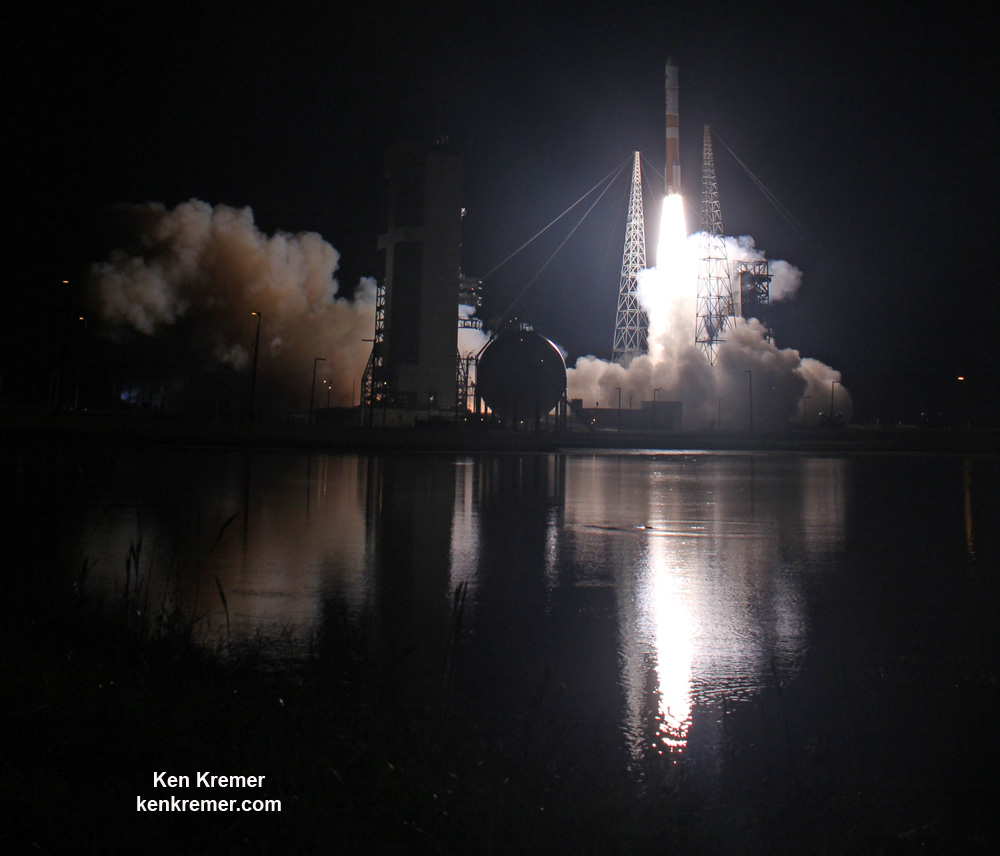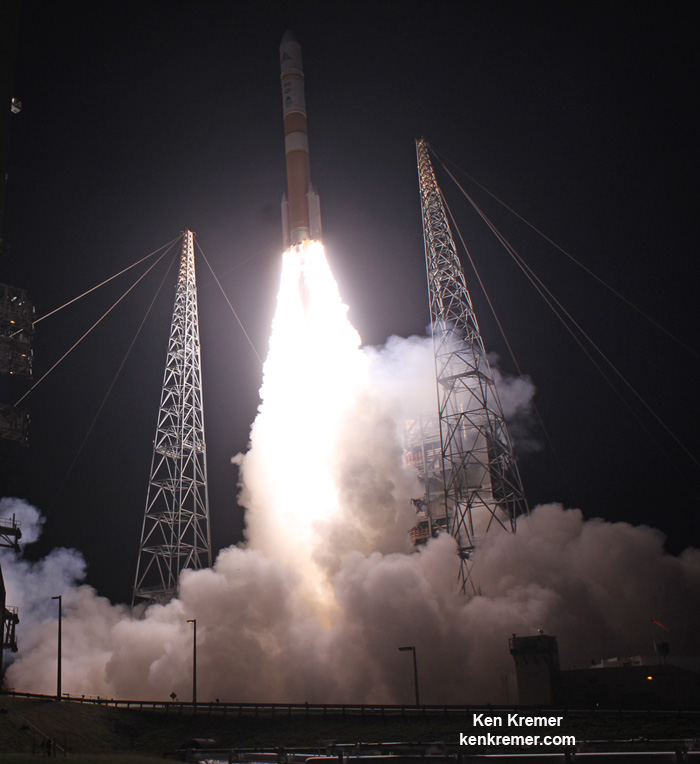
ULA Delta IV rocket poised for sunset blastoff with the WGS-9 mission for the U.S. Air Force from Cape Canaveral Air Force Station, Fl, on Mar. 18, 2017. Credit: Ken Kremer/kenkremer.com
CAPE CANAVERAL AIR FORCE STATION, FL - As sunset dawns on the venerable Delta rocket program, the sole Delta slated to launch from the Cape this year is set to dazzle at sunset tonight, Saturday, March 18.
And the launch site is drenched with brilliant blue skies this afternoon as I watched the Delta rocket exposed to the heavens as the mobile service tower rolled away from on site at pad 37.
Florida's Space Coast will light up with a spectacular sunset burst of fire and fury as a United Launch Alliance (ULA) Delta rocket roars to space with a super advanced tactical satcom for the U.S. Air Force that will provide a huge increase in communications bandwidth for American forces around the globe.
Blastoff of the Wideband Global SATCOM (WGS-9) mission for the U.S. Air Force is slated for 7:44 p.m. EDT on Saturday, Mar. 18, 2017 from Space Launch Complex-37 at Cape Canaveral Air Force Station, Florida.
WGS-9 will be delivered to a supersynchronous transfer orbit atop a ULA Delta IV Medium+ rocket.
Thus 'March Launch Madness' continues unabated tonight - with a dizzying pace of launches.
Because it's been barely two and a half days since a SpaceX Falcon 9 successfully dazzled sky watchers and launch enthusiasts on Thursday, March 16, just after midnight by delivering the EchoStar XXIII commercial television satellite to geosynchronous orbit - as I witnessed and reported on here.
So it's past time to 'get your ass to the Cape' - because the weather is glorious in central Florida. And … a Atlas rocket is slated to launch in only five or six days - late next week! in six next Friday.
Saturday's sunset launch window runs for one hour and 15 minutes from 7:44-8:59 p.m. EDT.
You can watch the Delta launch live on a ULA webcast. The live launch broadcast will begin approximately 20 minutes prior to liftoff at 7:24 p.m. EST here:
http://www.ulalaunch.com/webcast.aspx
The weather forecast for Saturday, Mar. 18, calls for a 90 percent chance of acceptable 'GO' weather conditions at launch time.
The primary concern is for cumulus clouds.
In case of a scrub for any reason the chances for a favorable launch dip just slightly to 80% GO on Sunday, March 19.
WGS-9 and her two sisters are the most powerful US Air Force military communications satellite ever built.
WGS-8 was launched on a Delta in December 2016.

A United Launch Alliance (ULA) Delta IV rocket carrying the WGS-8 mission lifts off from Space Launch Complex-37 at 6:53 p.m EDT on Dec. 7, 2016 from Cape Canaveral Air Force Station, Fla. Credit: Ken Kremer/kenkremer.com
It is the ninth satellite in the WGS constellation that serves as the backbone of the U.S. military's global satellite communications.
"WGS provides flexible, high-capacity communications for the Nation's warfighters through procurement and operation of the satellite constellation and the associated control systems," according to the U.S. Air Force.
"WGS provides worldwide flexible, high data rate and long haul communications for marines, soldiers, sailors, airmen, the White House Communication Agency, the US State Department, international partners, and other special users."

United Launch Alliance (ULA) Delta IV rocket carrying the WGS-8 mission for the U.S. Air Force launches at 6:53 p.m EDT on Dec. 7, 2016 from Cape Canaveral Air Force Station, Fl. Credit: Ken Kremer/kenkremer.com
The 217 foot tall Delta IV Medium+ rocket will launch in the 5,4 configuration with a 5 meter diameter payload fairing and 4 solid rocket boosters to augment the first stage.
The is the seventh flight in the Medium+ (5,4) configuration; all of which were for prior WGS missions.
WGS-9 also counts as the first of at least a trio of launches from the Cape this March- with the possibility for a grand slam fourth at month's end - if all goes well with another SpaceX Falcon 9 launch from pad 39A.
Stay tuned here for Ken's continuing Earth and planetary science and human spaceflight news.
Ken Kremer
No comments:
Post a Comment